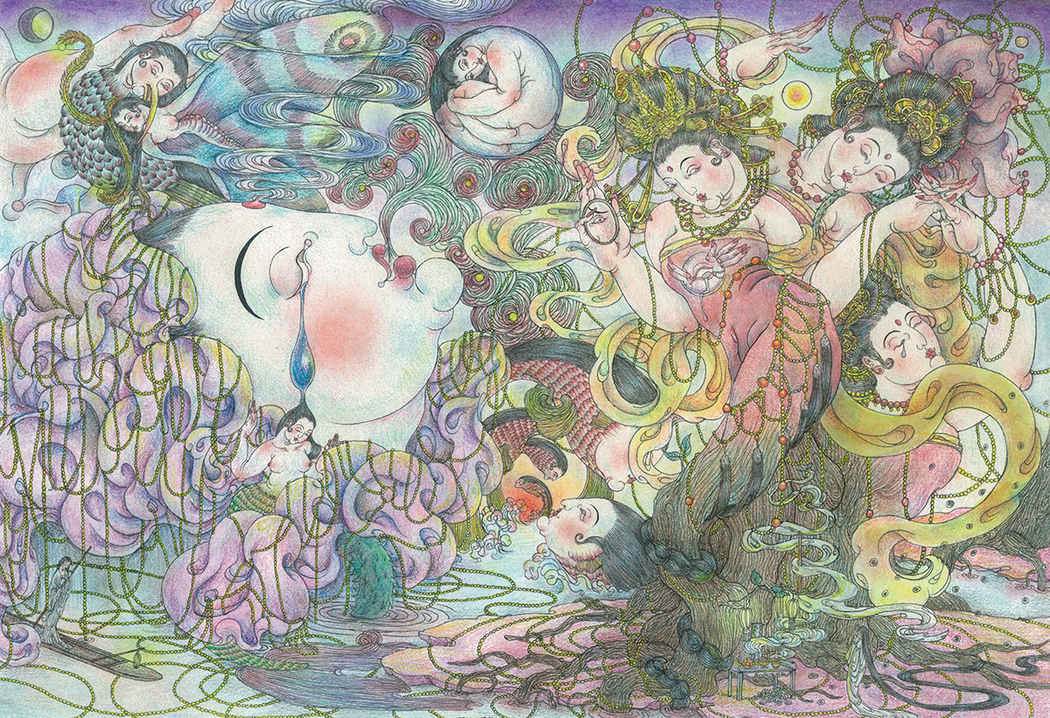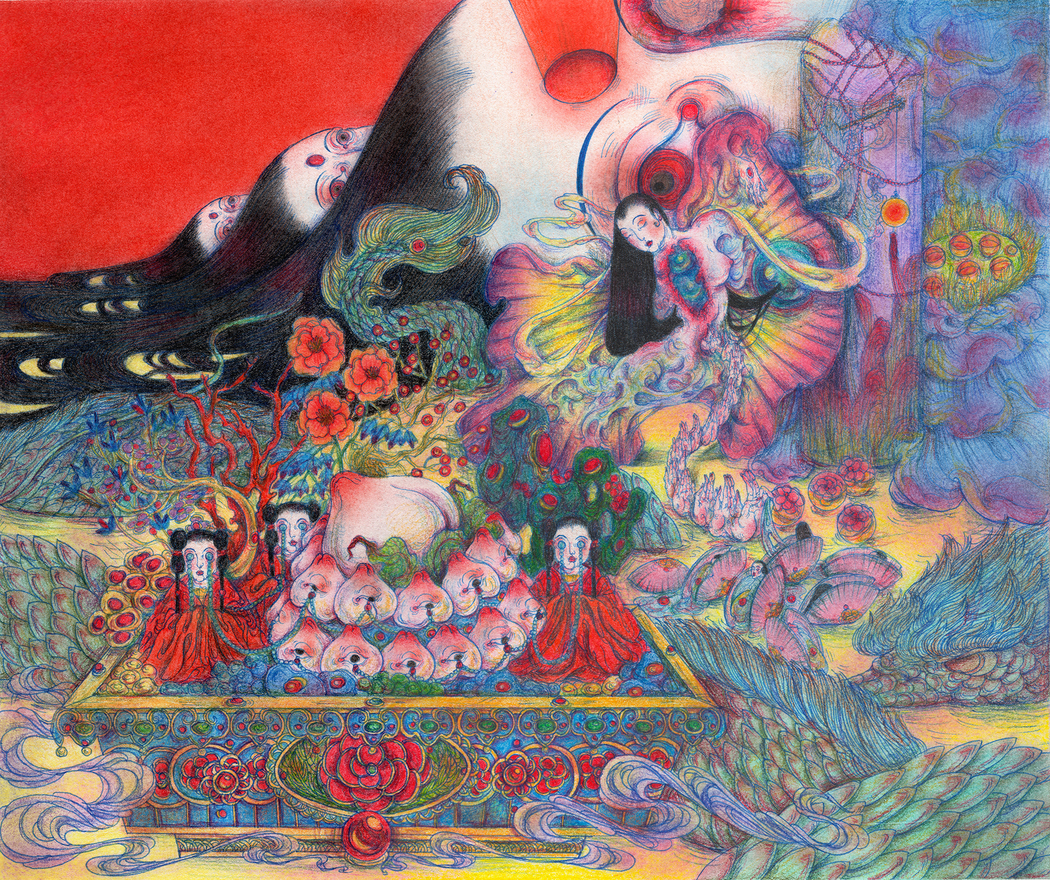Mosaz
Tracing Memory and Spirit: The Layered Worlds of Mosaz Zijun Zhao
By Anna Gvozdeva
In an age where visual culture is often defined by immediacy and spectacle, Mosaz Zijun Zhao’s work invites a different kind of encounter—one that is slow, introspective, and emotionally resonant. A New York–based artist originally from China, Zhao weaves a rich tapestry of tradition, personal spirituality, and cultural memory through her intricate, line-dense compositions. Her work does not shout; it whispers, drawing the viewer into layered emotional landscapes where reality and imagination coexist.
Born in 2000 and educated at the School of Visual Arts with a BFA in Illustration, Zhao occupies a unique position in contemporary fine art. Her practice is rooted in an exploration of identity—both inherited and self-defined—and her pieces are vehicles for both introspection and cultural dialogue.
At the heart of Zhao’s work lies a deep negotiation between tradition and her evolving spiritual self. This is not a static reconciliation but an ongoing dialogue—an interplay of reverence and reinvention. Her artistic process often begins with the deconstruction of traditional symbols and motifs, which are then reassembled in new, intuitive ways that reflect her inner emotional and spiritual terrain. This layering becomes a visual language through which the past is not only remembered but reimagined.
 Mosaz | A Joy Funeral | 2021
Mosaz | A Joy Funeral | 2021
Her technique reinforces this conceptual approach. Zhao’s hallmark is her use of meticulous, interwoven lines—each stroke deliberate, yet seemingly spontaneous. These lines are more than aesthetic devices; they are symbolic representations of memory, thought, and emotion. In this way, viewing her work becomes an act of contemplation, mirroring the meditative process through which it was created.
Memory is not just a theme in Zhao’s work—it is the medium itself. Drawing upon fragmented recollections of cultural rituals and personal experiences, Zhao constructs visual narratives that are at once intimate and universal. Her memories, incomplete and nonlinear, serve as fertile ground for reinterpretation. She fuses these fragments with research and historical iconography, yet always filters them through her personal sensibility.
“The ambiguity and layered details,” Zhao reflects, “encourage contemplation, emphasizing how memory is both a personal archive and a shared human experience.” Her works become emotional palimpsests, where history is neither static nor objective but a living, breathing force in her artistic imagination.
Zhao’s exploration of emotional and spiritual worlds is perhaps most vividly expressed in the way she translates abstract internal states into concrete visual elements. A strand of hair may symbolize confusion or emotional entanglement; an ethereal female form might embody softness, strength, or vulnerability. These recurring motifs act as bridges between the unseen and the seen, the felt and the rendered.
Subtle yet potent, these symbols pull viewers into a visual dialogue that transcends literal interpretation. Zhao’s work demands—and rewards—close looking. It is through this sustained gaze that meaning begins to emerge.
 Mosaz | Erysichthon | 2021
Mosaz | Erysichthon | 2021
While grounded in real-life experiences and cultural references, Zhao’s art frequently traverses into the realm of the dreamlike. Her process often begins with observation but ends in abstraction. The result is a kind of visual ambiguity—spaces where memory, fantasy, and reality collapse into one another.
This blending allows her to pose larger questions: What is real? What is remembered? And what is imagined? In Zhao’s world, these distinctions are not binary but fluid—mirroring the way we all navigate our own internal landscapes.
Zhao’s Chinese heritage remains a central axis around which her work revolves. Her upbringing steeped in traditional narratives and rituals—some remembered clearly, others distorted by time—provides the symbolic vocabulary of her art. These cultural touchstones serve not as static references but as evolving elements that she continuously recontextualizes to reflect the nuances of diasporic identity.
Through this lens, Zhao explores themes of displacement, belonging, and transformation. Her work becomes a visual bridge—linking the deeply personal with the broadly cultural, the historical with the contemporary.
Zhao’s impact on the international art stage is already considerable. Her work has been exhibited at prestigious venues including the National Museum of Science and Technology in Milan, Palazzo Bembo in Venice, CICA Museum in South Korea, and Fukuoka Asian Art Museum in Japan. Her accolades include the International Prize Leonardo da Vinci and the Premio Firenze XLI Edizione.
She has also been featured in prominent art publications such as Art Maze Mag, BOOOOOOOM, The Woven Tale Press, and AI-Tiba9 Art Magazine, underscoring the international reach of her artistic practice.
To describe Zhao’s work in three words, as she once did herself: emotive, myself, layered. These descriptors are not only fitting—they are essential. Her art is a mirror of her inner world, carefully layered with emotion, memory, and cultural resonance.
Zhao’s artistic vision is already mature and distinct. She reminds us that art can be both quiet and powerful, both deeply personal and broadly relevant. In a world that often demands instant understanding, Mosaz Zijun Zhao offers something far more valuable: an invitation to slow down, to reflect, and to enter a space where the seen and unseen dance together in delicate, intricate lines.
 Mosaz | Longevity | 2024
Mosaz | Longevity | 2024

Leave a Reply